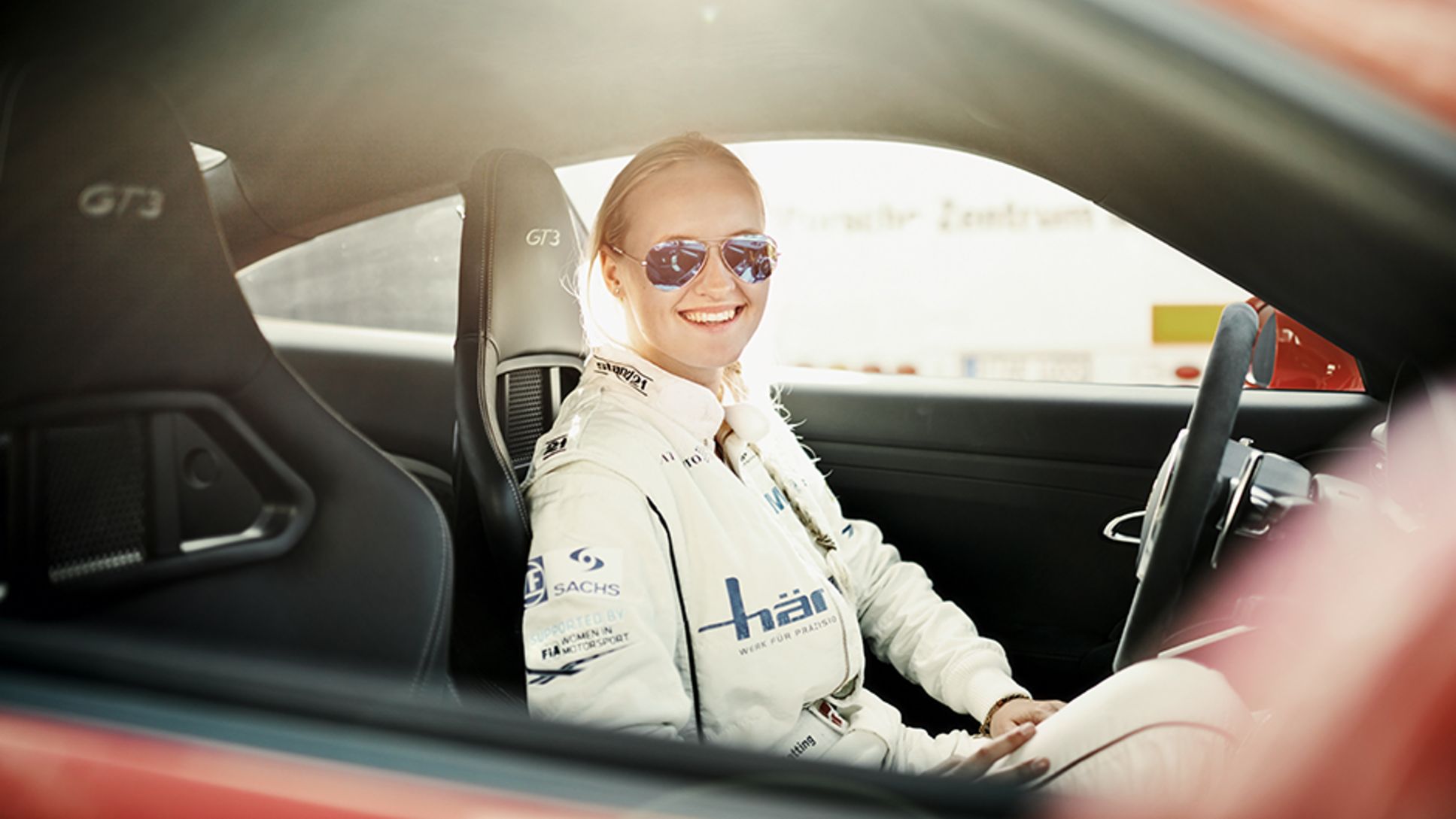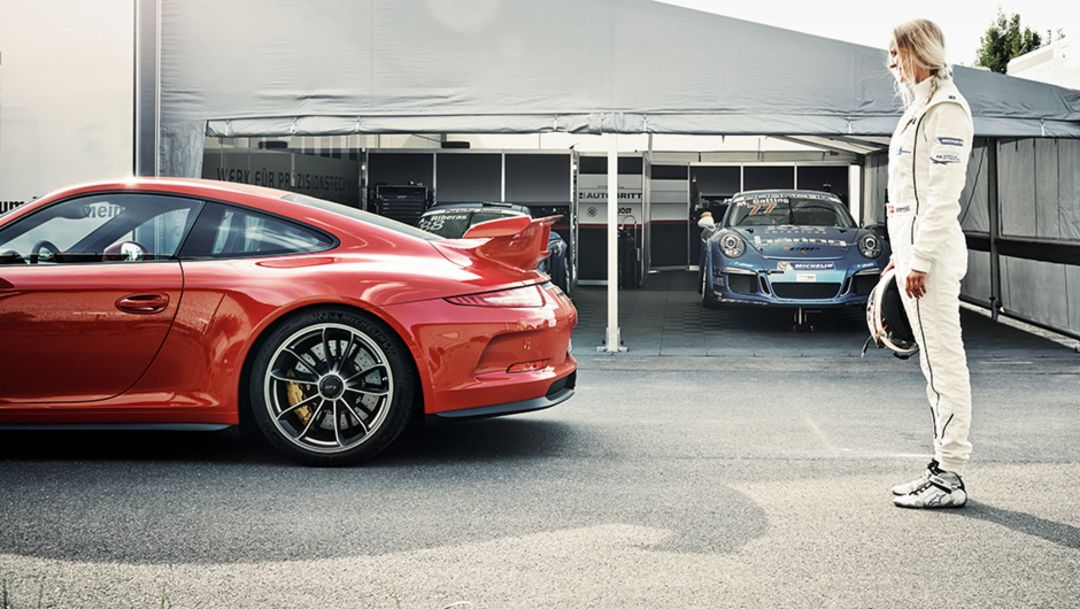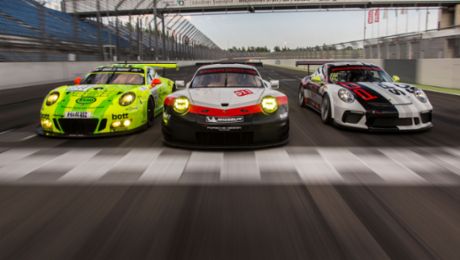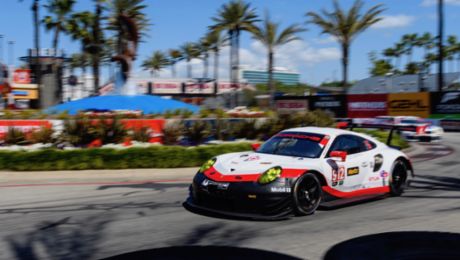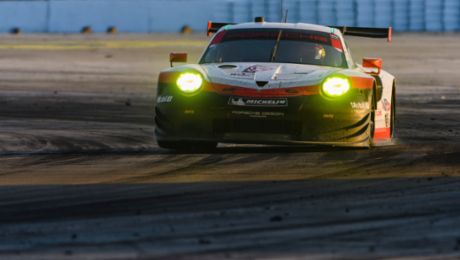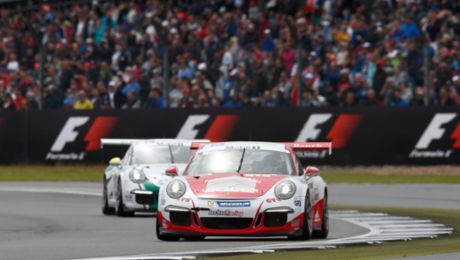Michelle Gatting is a tough girl. The 20-year-old danish professional race-car driver not only battles the big guys on the racetrack. Her hobbies include fitness, boxing, and CrossFit workouts (which the U.S. Army uses to keep its troops-in-fighting trim). “ And the 911 GT3? Why, it’s the most extreme representative of its kind. Every Porsche carries the racing gene, of course, but this one is the ultimate performer. And no, not because of the bright red paint. It’s just one small step from the street-legal 911 GT3 to its brother, the 911 GT3 Cup race car. No other 911 comes closer. The 3.8-liter six-cylinder boxer engine produces 350 kW (475 hp), and takes the street version from zero to 100 km/h in a mere 3.5 seconds.
Street version GT3 and Cup car meet in Nuremberg
The two 911 brothers meet in Nuremberg. The occasion: a Porsche Carrera Cup Deutschland race on the Norisring, where the racing version of the 911 GT3 will be put through its paces. Since the start of the season, there has been one woman among the nearly forty contenders in the starting lineup for the one-make cup. That one woman is Michelle Gatting. It’s nothing new for her. “I’ve been racing for thirteen years. And most of my rivals have been guys,” she says with a shrug. She strolls out of the hotel in a pair of shorts, T-shirt, and strap sandals. She’ll be driving the “civilian” 911 GT3 to the racetrack. But first things first: Gatting stands in front of the car. “The car is simply gorgeous,” she says reverently. “I especially love the wide rear end. The magnificent tail, the large wheel arches, the rear wings, and the wide tires—those are all I need to see the relationship to racing.”
Michelle Gatting slides her 1.81-meter frame into the bucket seat of the 911 as though it were a custom-fit tube dress. “The seat is just like a real racing bucket seat, but still comfortable,” she says. Thanks to the long thigh support, there is even sufficient grip for her legs. Before heading off to the racetrack, she purposefully presses the Sport exhaust button: “That makes the engine sound even more like a race car!”
If you want to feel something, you should hear it as well. No sooner has she fastened her seat belt than she reaches for the paddle shifts on the steering wheel. Changing gears like this is second nature to her. The Cup vehicle based on the 991 model generation also has these paddles on the steering wheel.
A radically overhauled PDK
The 911 GT3 features a radically overhauled Porsche double-clutch transmission (PDK). Initially designed for racing, it has the characteristics of a sequential racing transmission. The response times are in a range once reserved for the realm of motorsports. The “quick shift” even makes reaction times of less than 100 milliseconds possible. The professional’s verdict? “Superfast gear changes, absolutely perfect: it doesn’t get any better than this in a road-going car.” In her Cup car, a six-speed constant mesh transmission developed by Porsche Motorsports takes over the task of transmitting the race car’s 338 kW (460 hp) to the rear axle by means of a self-locking differential.
For the drive through town, Gatting selects the Automatic option and serenely rolls through the heavy traffic. “I really think it’s great that the 911 GT3 is so perfect for everyday situations and that you can use it to just cruise through town. But for me personally, I’d rather be on the highway or at the racetrack.” This native of Denmark is not the only one who needs to experience this super athlete at the limit, to tease out the maximum performance, to see how far she can go. Around 80 percent of all 911 GT3s sold are driven on racetracks, as well. That is where the dynamic handling of the Porsche really shines.
Having arrived at the temporary Norisring city racecourse, Gatting vanishes into the truck of her Attempto team. Out of her leisure apparel, into her racing overalls. The 911 Cup, number 77, is waiting in the team tent. Her race car. It is strikingly similar to the bright red 911 GT3 that she has just parked. If you disregard the colorful sponsor stickers, the most visible difference is the significantly higher rear wing on the Cup car.
The interior of the 911 Cup is pretty much cleared out
There are, of course, further differences between the street-legal and the racing version. This becomes crystal clear when you take a look at the cockpit. In the street-legal version, black Alcantara, brushed aluminum, and leather create an ambience at once elegant and sporty. In contrast, the interior of the 911 Cup was pretty much cleared out. Only the racing bucket seat with six-point seat belts, a fire extinguisher, and the safety cage remain. The interior is unquestionably austere. The significantly smaller steering wheel is adorned with a number of colorful buttons, but in a nod to brotherhood, the rim is covered by black Alcantara.
There was a reason for this crash diet: weight. And yet, at 1,430 kilograms (empty), the street-legal GT3 is already a lightweight. But the racing version weighs a mere 1,175 kilograms, a full 255 kilos lighter. Soundproofing was also sacrificed in the name of weight reduction. Loud? Naaaah. Gatting enjoys the soundscape: “This way, you hear the boxer engine even better.”
Some stretches of the city racecourse have already been blocked off, allowing Gatting to step on the gas in her street-legal 911—for the perfect comparison, as it were. The Porsche engine speed concept could have been created with her in mind. This is the first street-legal 911 to feature gasoline direct injection. In combination with other high-performance details and a rocker arm valve control, the result is a high-revving engine that can achieve up to 9,000/min. Michelle Gatting is in her element. The new, active rear-axle steering system enables particularly dynamic cornering maneuvers in the GT3, and it is even more agile on bends. She is elated about that, too, because this gives the car the maneuverability of a racing kart, which is where she—and nearly all young race drivers—first learned her craft.
The Porsche rear-axle steering also enhances the car’s day-to-day usability. It is triggered by the system at speeds below 50 km/h. The result is a smaller turning circle, which facilitates maneuvering and parking.
No electronic support in a race
In a race, Gatting has to forgo the electronic support. No ABS, no PSM (Porsche Stability Management), no traction control, no traction slip control system. “You’re supposed to learn to control the handling performance by means of the gas pedal, brake, and clutch,” Gatting says, explaining the purpose of the Cup rules. “It’s the driver’s skill that counts.” In motorsports, it’s safe to say that anyone who is fast in a 911 will be fast in any other racing car as well. And Gatting has proven the truth of this rule of thumb in an unusual driving test. She was one of ten young European drivers invited by the Fédération Internationale de l’Automobile to participate in a comprehensive selection process in order to qualify for prestigious sponsorship by the FIA Institute Academy. How did it go? “I was the fastest in Europe,” the tough girl says softly.
Info
Text first published in the Porsche customer magazine Christophorus, No. 368.
Consumption data
911 GT3: Fuel consumption combined: 12,4 l/100 km ; CO₂ emissions: 289 g/km
